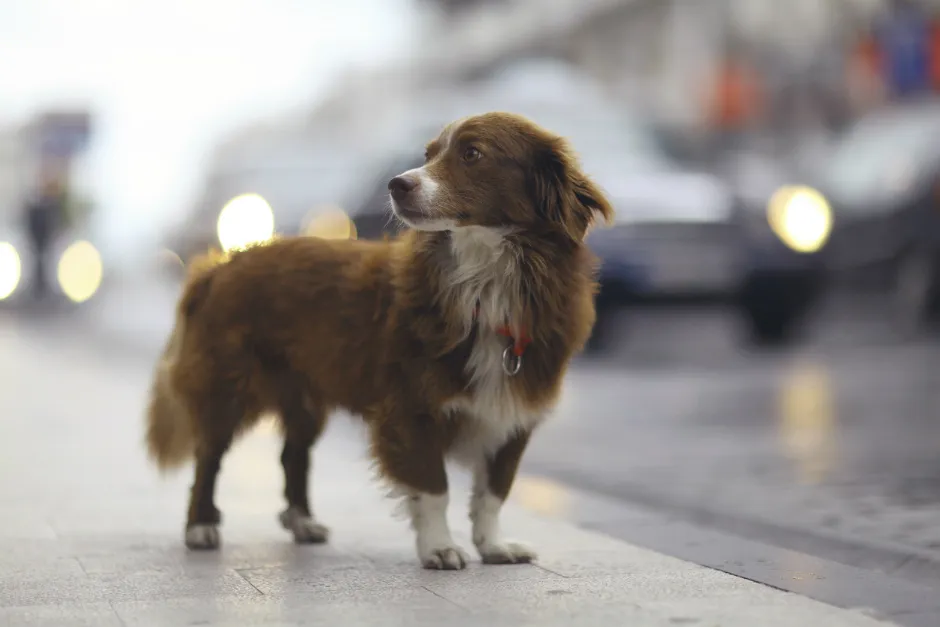What to do if you find a lost or abandoned dog?

Approach the dog
If the dog looks healthy and doesn't show an aggressive attitude, you may try to approach it. An abandoned or lost dog is confused, and can easily get scared and run away if you approach it in a abrupt or direct way. For this reason it is important that you come closer little by little while avoiding any sudden movements. Use a soft voice and certainly do not talk in a menacing tone. If you happen to have some food on you, you can use it to make the dog feel at ease. But instead of trying to draw it towards you, it is better to throw the food away from you. The dog will come closer to you as its trust is growing. If it is hot, it could be useful to offer some water as well, to help it relax in your presence.
Once the dog is near and its behaviour is calm, you can try to stroke and hold it. If it has a collar, doesn't seem aggressive and lets itself be handled with ease, you can apply a leash or a piece of rope or just hold the collar with your hand. If it isn't wearing a collar, you can improvise a leash with the help of some rope.
Tips: If the dog is injured or ill or showing signs of aggressiveness, it is better to stay near and call the authorities so they can come and collect it. If you want to give it first aid, it is important that you know how to handle it to avoid hurting it as well as to avoid the dog hurting you in defence.
Once you have it secured, there are two options, depending on whether it has a dog tag:
If it carries a tag
A dog tag usually carries the name of the animal and a telephone number. If the number is up to date, with a little luck the owner will answer you straight away and you may be able to tell them you have found their dog.
Some modern dog tags instead of a telephone number have a QR code: if you have a smartphone and scan the code, you will have access to all the information the owner of the dog has left for it to be located.
In case the owner doesn't answer, the number is not updated or you can't read it or you are not able to get near the dog and handle it, you can act as if it didn't carry a dog tag.
Tips: Not all animals walking alone are abandoned, especially in build-up areas. Simply ringing someone's doorbell and asking if they know the dog may be the fastest way to solve the situation.
If it doesn't have a tag
In this case, stay with the dog in the place where you found it for a reasonable time to allow for the owner, who may be looking for it, to appear.
The next step could be to take the dog to the nearest veterinarian clinic to check for free if it carries a microchip in order to locate the owners this way. In case it carries a microchip, the veterinarian can access the information and get into contact with the owner. It is possible as well that the vet recognizes the dog and is able to warn the owner without it needing to carry a microchip.
Another option is calling the local police, the Guardia Civil or the Town Hall. If the owner is looking for their dog, it is likely they will have called the authorities to inform them about their dog on the loose. Besides, local authorities usually dispose of a microchip reader so that they can contact the owner immediately in case the dog carries one.
Does the dog have no microchip, then both the veterinarian and the local authorities can call a dog warden to take the animal to a municipal kennel or in some cases a shelter.
Tips: Municipal kennels and shelters are not the same thing. The first, also called animal health centres, are the collection centres for abandoned animals provided for by the public administration, the latter are non-profit associations dedicated to the protection of animals, though in some cases they possess a municipal concession to manage the service of collecting abandoned animals. In most kennels dogs tend to be sacrificed if their owner does not claim them and no adopter appears before their stay has surpassed a fixed term. In shelters animals are never sacrificed, except in exceptional cases such as terminating a sick animal's suffering, so dogs may sometimes live all their life on the premises of a shelter.
If it doesn't have a microchip
That a dog does not carry a microchip doesn't necessarily mean it is abandoned. The dog could merely be lost. Nevertheless, without identification the chances of finding the animal back are reduced. In this situation, apart from contacting the collection service contracted by the local authorities, you have three options:
- You can contact local shelters to find out if someone has called to notify its disappearance. Most shelters are saturated, though, and cannot take care of the dog before the owner has been located.
- You can temporarily take care of the dog as long as you let it be known you have found it or you can help with finding a new household. You could make posters and hang them in veterinarian clinics and in establishments of the locality and its surroundings where you found the dog. You could also hang a notice on Internet pages dedicated to lost animals. Local shelters may help you spread your message
- You can offer it your own household and start the procedure for adoption.
Abandonment or getting lost is perhaps the most traumatic experience a pet animal can have. Your help and commitment can make it less traumatic.